
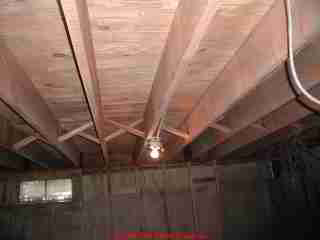
Guide to Mold Removal by Media Blasting
- POST a QUESTION or COMMENT about mold removal using media blasting: how to remove mold contamination from irregular or hard-to-access surfaces
Guide to media blasting for cleaning mold-contaminated surfaces: this document reprints our article on use of baking soda media blasting for surface cleaning in the removal of mold and fungal growth from building surfaces. This material is reprinted from "Testing the effectiveness of baking soda media blasting for cleaning fungal contamination in buildings,"
The media can be baking soda (discussed here) or dry-ice particles. Both are equally effective. The dry-ice or frozen CO2 method has the advantage of producing less media particulates which add to the volume of dust and debris needing to be vacuumed and removed after blasting--DJF].
InspectAPedia tolerates no conflicts of interest. We have no relationship with advertisers, products, or services discussed at this website.
- Daniel Friedman, Publisher/Editor/Author - See WHO ARE WE?
Report on Tests of the effectiveness of baking soda media blasting for cleaning and removal of fungal contamination in buildings
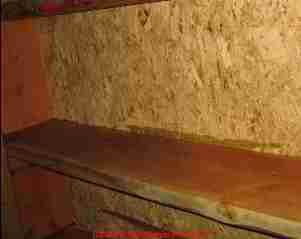 Dennis Melandro, First Alert Emergency Services, Rockville Centre, NY,
Dennis Melandro, First Alert Emergency Services, Rockville Centre, NY,
Daniel Friedman, American Home Service, Poughkeepsie, NY.
Media Blasting Decision and Procedure for Mold Remediation
Media blasting is particularly useful for thorough cleaning of irregular building surfaces such as the under-side of a roof deck or other attic or building surfaces where nails protrude, or where cross bracing or bridging obstruct building surfaces and prevent easy cleaning by simple scrubbing.
Media blasting is also suitable for thorough cleaning in difficult-to-access areas such as tight crawl spaces and attics where mold growth needs to be removed.
[OPINION: Media blasting is a very effective way to clean irregular or hard-to-access moldy surfaces in buildings, and it avoids the moisture surge and possible moisture damage to other building areas that can occur when wet methods such as power washing are used indoors.]
In the first half of this article, Dennis Melandro, a mold remediation contractor reports on field experience regarding baking soda media blasting for surface cleaning during mold remediation.
In the second half of the article Daniel Friedman, a building diagnostician and forensic microscopist reports on laboratory test results for samples collected to evaluate the effectiveness of Mr. Melandro's cleaning effort.
This mold remediation example photograph (by DJF) shows an oriented strand board (OSB) subfloor after cleaning using a blasting method and sealing using
Fosters 4051™ clear coating. The remaining photographs in this article were taken at the study site or in the laboratory described in this report.
While we have performed the baking soda media blasting technique many times to clean irregular building surfaces, here we report on a specific test case for which we collected a variety of samples selected to test the effectiveness of the cleaning process at several points.
Remediation of large areas of fungal contamination in residential and commercial buildings is usually performed by a company with experience in construction demolition and cleaning, airborne particle contaminant control and use of special equipment to protect both workers and building occupants from contaminated or irritating dust and organic debris.
When large areas are contaminated, mold remediation should follow a protocol specified by an independent third party who has expertise in defining the scope of work and experience in recognizing, sampling, and identifying problematic mold in buildings. These experts are drawn from several professions including industrial hygiene, mycology, aerobiology, and building science.
Dennis Melandro, received a protocol for a single-family, two-story home with full, unfinished basement. The house was wood-frame construction. It was an unoccupied rental property in which a basement pipe break and leak had gone undiscovered for approximately three weeks.
By the time Melandro was contacted, the basement had heavy visible mold growth on the two- by eight-inch joists, sub-flooring of the floor above, and on the triple two- by 10-inch main headers. Insulation and the building contents were assumed to be contaminated as well. The first floor consists of four rooms, all of which had mold on plaster walls, and ceilings. The second floor has two bedrooms where mold was visible on the walls.
The client's insurance company's protocol specified removal of all basement ceiling joists, supporting girders, and first floor subfloor, along with the building contents. In other words they specified that the entire first floor structure be removed. There was no mention of how the house was to be supported during this step. All wall and ceiling coverings were also to be removed.
In Melandro's view, the call for complete framing removal was drastic and unnecessarily costly, particularly as in this instance there was no report that the building structure had been damaged by fungal contamination.
As an alternative approach, I proposed removal of mold contamination from the framing surfaces using the Armex Accustrip™ system. This method entails a high-pressure compressed-air spray (consisting of a hopper holding the baking soda and a handheld gun for precision) using a baking soda abrasive.
We've found that this method cleans irregular and problem surfaces such as subfloor with protruding nails and the multiple building framing cavities which would otherwise be both labor intensive and difficult to clean by manual scrubbing and vacuuming. I proposed that the Armex™ process be used to remove mold spores from the ceiling joists and main triple headers (as well as other surfaces).
The spray blasting was to be followed by HEPA vacuuming to remove any media or debris residue, followed by vacuuming with a bio-wash. The client accepted my proposal. The problem area before and after our blasting treatment is shown in Photos 1 and 2 above.
In order to contain the mold, debris and baking soda residue while using the Armex Accustrip™ system, we kept the first-floor sub-floor in place until the media blasting was completed. Then, we removed the first-floor sub-floor and we hand sanded the now-exposed top side of the joists, followed by HEPA vacuuming and damp wiping.
In other scenario's where there are windows, doors and opening we would set up critical barriers to contain the residue from the media blasting, while an air scrubber is filtering the air borne mold spores, baking soda and residue from the surface of which this method is being applied. During this procedure, all personnel were equipped with protective clothing and respirators.
When the mold remediation was complete, samples of the remediated surfaces were examined. To evaluate the effectiveness of our cleaning effort, we called on Daniel Friedman, an independent aerobiologist with expertise in both building inspection and fungal spore identification.
Mold Removal by Media Blasting of the Moldy Surface: A test of effectiveness - Mold Lab Testing Results
In the aerobiology lab Daniel Friedman examined the tape samples of surface particles and debris from the remediation project. Samples were studied using a very high powered light forensic microscope (up to 1920x polarized light microscopy and simple micro chemical methods) and appropriate slide preparation methods. Melandro and Friedman had agreed on the time, type and location of surface samples to be collected during the project.
Friedman's own research as well as that of others in the field indicate that surface sampling combined with visual inspection is both more reliable and more important than stand-alone air sampling or culturing methods for characterizing building contamination.
Chaetomium globosum, Chaetomium aureum and Stachybotrys chartarum are dark "black molds" frequently found in buildings that have been subjected to flooding. Their medical risk has been somewhat overblown by the excited news media, but they are indeed telltale organisms very often pointing to a presence of more serious fungal contaminants such as Penicillium sp. and Aspergillus sp. in the same buildings.
These latter molds are lighter in color and often grow hidden within building cavities. Unless they are quite heavy, colonies of these genera are often missed by a casual inspection which finds and reports "toxic black mold."
Because we wanted to understand the effects of blasting and to evaluate the possibility of recontamination of the 'cleaned' surface by fungal debris that might be transported by airborne blast-media, we decided to examine samples of surface conditions at several steps in the cleaning process:
Surface Mold Contamination Screening Tests performed after media blasting with baking soda and before HEPA vacuuming
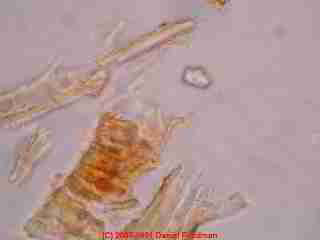 ...
...
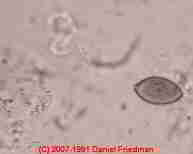
After media blasting with baking soda and before HEPA vacuuming, the sample area included contamination,
which I speculate settled as airborne debris.
In these mold test samples, Mr. Friedman found fiberglass fragments, debris, cellulose fragments more frequent than in after-HEPA vacuuming sample below,
and he found both individual fungal spores spore clusters including basidiospores, Periconia sp., and unidentified fungal conidia and
hyphal fragments which appeared to be Chaetomium globosum particles, perhaps fractured by the blasting process.
See the photos here which show cellulose fragments and Chaetomium globosum. On other studies, Daniel Friedman has also found fairly uniform surface contamination by fungal debris, mostly hyphal fragments, when an inexperienced contractor used contaminated wipes and a contaminated vacuum attachment across many surfaces.
Surface Mold Contamination Screening Tests After HEPA vacuuming and wiping
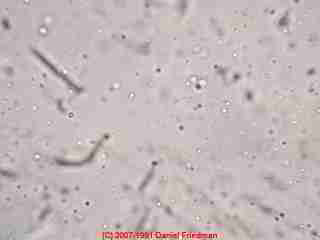
After HEPA vacuuming and wiping, the sample was clean of fungal spores.
It contained incidental occurrences of media particles less than one micron in size, cellulose particles that Friedman speculates were removed from the blasted wood surfaces, and skin cells.
There were no fungal spores found in the sample, as shown in the photograph.
Media Blasting Test Results, Comments by Daniel Friedman
These results suggest that the media blasting approach is effective in cleaning exposed wood surfaces of fungal contamination, but that special care needs to be taken to avoid recontamination by airborne, contaminated dust, vacuum attachments, or surface wipes.
Contractors need to look carefully at dust control, vacuuming and wiping methods to take full advantage of the cleaning provided by surface blasting.
While more research would be useful to refine the procedure and confirm its long-term efficacy, even with these incomplete pre and post-blasting tests there was good evidence that there was no substantial post-blasting and cleaning surface contamination.
Media Blasting Test Results, Comments by Dennis Melandro
First Alert Emergency Services has completed numerous mold remediation projects. We have saved structures and have received successful final clearance test results leaving both residential and commercial building owners very pleased with our completed projects.
The media blasting process is more cost effective and less time consuming than extensive demolition. Most importantly, the final result is a cleanup which has successfully removed the problem mold in order to provide a mold-safe indoor environment.
We've had great success using the media blasting method for mold, and we've also used it for the removal of soot from roof rafters, ceiling joists, sub-flooring and wall framing. As it is less abrasive and thus less destructive to brick than sand blasting, it and can be used on masonry exteriors as well.
By contrast with common remediation methods which hand clean and seal the framing and sub-floor, leaving everything white or shiny with paint, the media-blasting process leaves a fresh, clear wood surface at which you would never know that there was a previous fire or mold problem. The contamination has been removed.
...
Reader Comments, Questions & Answers About The Article Above
Below you will find questions and answers previously posted on this page at its page bottom reader comment box.
Reader Q&A - also see RECOMMENDED ARTICLES & FAQs
On 2022-01-18 y Inspectapedia Com Moderator (mod) - basics of cleaning up wet moldy wall cavities
@Jade,
Remove the mold from exposed surfaces.
Throw away moldy or mold suspect insulation or insulation that has been wet.
You might want to use a fungicidal ceiling paint before putting the building back together.
See
FUNGICIDAL SPRAY & SEALANT USE GUIDE
Watch out: Don't put it back together until all of those areas are dry and free of mold. This repair is very straightforward. and common.
On 2022-01-16 by Jade - wet wall cavities & insulation in new construction
HELP PLEASE! New construction problem! And I'm allergic to mold!
The insulation was slowly installed over weeks in a new build (a suite addition onto our home) in wood framing exterior walls 2 months ago. Vapor barrier had not yet sealed off the ceiling, relative humidity went way up with weeks of unprecedented rain (we're on the west coast of canada in the winter!), and then we had a severe cold snap for a few weeks.
We have found that moisture was trapped behind all the rockwool insulation to the degree that all the plywood has a new, dark mottled water damage/ likely-mold staining.
There is no visible fuzzy mold, but significant new dark staining. We have pulled out all the insulation, which feels dry to the touch, but will clearly have mold spores all over it. How do we handle this?
How do we clean all the plywood and framing on this entire suite?
How do we know how far to go with this? Test the plywood to see whats growing first?? That will likely take a significant amount of time!
Advice please
Thank you!
On 2021-11-29 by Inspectapedia Com Moderator (mod) - don't buy a baking soda blaster for a one-off job
@Old home diy renovator,
Absolutely, and thank you for the comment.
We never intended to suggest that everyone should run out and buy a $4,000 cleaning machine.
These machines are normally owned by remediation companies who provide restoration and cleaning services
On 2021-11-29 1 by Old home diy renovator
This all sounds great, except that baking soda blaster costs $4,000!
What can the average diy homeowner do?
Or are there companies I can hire that already own that blaster who can do it for a reasonable fee?
Thank you!
On 2018-08-04 by (mod)
No.
Using a disinfectant may "kill" some mold genera/species spores but could still leave toxic or allergenic "dead" particles in a building.
Peroxide, as it is foamy, may also help with cleaning a surface.
But just spraying something is not a subsitute and will not correct a mold problem. You need to remove the mold, clean the surfaces, and correct its cause.
On 2018-08-04 by Mike Smith
I've been told mold can be removed using 3% hydrogen peroxide or more. True?
On 2018-04-04 by (mod)
If the wood is dry and the windows are sealed you should not have much concern for the mold you describe; in fact without a test we can't assert that the mold is not simply cosmetic. I'd not go to great trouble nor cost about this issue unless there is other data indicating an indoor mold problem.
On 2018-03-25 by Anonymous
A bad contractor installed windows when there was mold growing on the wood that the window frame abutts. How can I kill the mold without removing the windows?
...
Continue reading at TRAPPED MOLD BETWEEN WOOD SURFACES or select a topic from the closely-related articles below, or see the complete ARTICLE INDEX.
Or see these
Recommended Articles
- MOLD CLEANUP GUIDE- HOW TO GET RID OF MOLD - home
- MOLD CLEANUP - MISTAKES to AVOID
- TRAPPED MOLD BETWEEN WOOD SURFACES
Suggested citation for this web page
MOLD REMOVAL, MEDIA BLASTING at InspectApedia.com - online encyclopedia of building & environmental inspection, testing, diagnosis, repair, & problem prevention advice.
Or see this
INDEX to RELATED ARTICLES: ARTICLE INDEX to MOLD CONTAMINATION & REMEDIATION
Or use the SEARCH BOX found below to Ask a Question or Search InspectApedia
Ask a Question or Search InspectApedia
Questions & answers or comments about mold removal using media blasting: how to remove mold contamination from irregular or hard-to-access surfaces
Try the search box just below, or if you prefer, post a question or comment in the Comments box below and we will respond promptly.
Search the InspectApedia website
Note: appearance of your Comment below may be delayed: if your comment contains an image, photograph, web link, or text that looks to the software as if it might be a web link, your posting will appear after it has been approved by a moderator. Apologies for the delay.
Only one image can be added per comment but you can post as many comments, and therefore images, as you like.
You will not receive a notification when a response to your question has been posted.
Please bookmark this page to make it easy for you to check back for our response.
IF above you see "Comment Form is loading comments..." then COMMENT BOX - countable.ca / bawkbox.com IS NOT WORKING.
In any case you are welcome to send an email directly to us at InspectApedia.com at editor@inspectApedia.com
We'll reply to you directly. Please help us help you by noting, in your email, the URL of the InspectApedia page where you wanted to comment.
Citations & References
In addition to any citations in the article above, a full list is available on request.
- In addition to citations & references found in this article, see the research citations given at the end of the related articles found at our suggested
CONTINUE READING or RECOMMENDED ARTICLES.
About the Authors
Dennis Melandro is an ASCR certified restorer, MEHRC mold supervisor, IAQA certified mold remediator and an expert in mechanical hygiene for HVAC systems. He founded First Alert Emergency Services and has been servicing the insurance industry for fire, water, smoke and mold remediation for the past 14 years. He can be reached by e-mail to info@firstalertemergency.com or by phone at (800) 924-1119.
Daniel Friedman is an aerobiologist specializing in fungal spore identification. He has worked as a building failures investigator since 1978 and has specialized in indoor mold contamination and fungal spore identification since 1986. His laboratory is in Poughkeepsie, N.Y. His background and credentials are at InspectAPedia.com/danbio.htm. He can be reached via his online contact information. In-depth building diagnosis and repair research and advice can be read at Mr. Friedman's website InspectAPedia.com. Reprinted with permission from the JUNE 2003 edition of Indoor Environment Connections newspaper. Daniel Friedman - principal author/editor of the InspectAPedia® Website.
- MOLD CLEANUP GUIDE- HOW TO GET RID OF MOLD - guidelines and step by step advice for cleaning up mold
- MOLD CLEANUP - MISTAKES to AVOID that people make when cleaning mold on wood surfaces in buildings
- MOLD SANITIZER, SPRAY, BIOCIDE USE GUIDE - when and how to use or not use biocides, washes, and encapsulants in moldy buildings
- The Use of Ozone Generators Indoors for Control of Odors and Mold Removal in buildings: A Summary of Hazards and False Claims
- What indoor humidity should we maintain in order to avoid a mold problem?
- MOLD PREVENTION GUIDE: Correct the Causes of Mold and Prevent Indoor Mold or other indoor environment problem
- Mold Prevention: Avoiding Mold Problems in buildings by Using Mold-resistant Construction Products & Practice
- Our recommended books about building & mechanical systems design, inspection, problem diagnosis, and repair, and about indoor environment and IAQ testing, diagnosis, and cleanup are at the InspectAPedia Bookstore. Also see our Book Reviews - InspectAPedia.
- ENVIRONMENTAL HEALTH & INVESTIGATION BIBLIOGRAPHY - our technical library on indoor air quality inspection, testing, laboratory procedures, forensic microscopy, etc.
- Adkins and Adkins Dictionary of Roman Religion discusses Robigus, the Roman god of crop protection and the legendary progenitor of wheat rust fungus.
- Kansas State University, department of plant pathology, extension plant pathology web page on wheat rust fungus: see http://www.oznet.ksu.edu/path-ext/factSheets/Wheat/Wheat%20Leaf%20Rust.asp
- A BRIEF GUIDE to MOLD, MOISTURE, and YOUR HOME, [PDF] U.S. Environmental Protection Agency US EPA - includes basic advice for building owners, occupants, and mold cleanup operations. See http://www.epa.gov/mold/moldguide.htm
- US EPA - MOLD REMEDIATION in SCHOOLS & COMMERCIAL BUILDINGS - - US EPA
- US EPA - UNA BREVA GUIA a MOHO / HONGO - en Espanol
- A BRIEF GUIDE to MOLD, MOISTURE, and YOUR HOME, [PDF] U.S. Environmental Protection Agency US EPA - includes basic advice for building owners, occupants, and mold cleanup operations. See http://www.epa.gov/mold/moldguide.htm
- "Disease Prevention Program for Certain Vegetable Crops," David B. Langston, Jr., Extension Plant Pathologist - Vegetables, University of Georgia (PDF document) original source: www.reeis.usda.gov/web/crisprojectpages/209797.html
- Disease Prevention in Home Vegetable Gardens [PDF], Patricia Donald,Department of Plant Microbiology and Pathology,
Lewis Jett
Department of Horticulture, University of Missouri Extension - extension.missouri.edu/publications/DisplayPub.aspx?P=G6202 - "Management of Powdery Mildew, Leveillula taurica, in Greenhouse Peppers," Ministry of Agriculture and Lands, British Columbia - Original source: www.agf.gov.bc.ca/cropprot/peppermildew.htm
- Fifth Kingdom, Bryce Kendrick, ISBN13: 9781585100224, - we recommend the CD-ROM version of this book. This 3rd/edition is a compact but comprehensive encyclopedia of all things mycological. Every aspect of the fungi, from aflatoxin to zppspores, with an accessible blend of verve and wit. The 24 chapters are filled with up-to-date information of classification, yeast, lichens, spore dispersal, allergies, ecology, genetics, plant pathology, predatory fungi, biological control, mutualistic symbioses with animals and plants, fungi as food, food spoilage and mycotoxins.
- Fungi, Identifying Filamentous, A Clinical Laboratory Handbook, Guy St-
- US EPA: Mold Remediation in Schools and Commercial Building [Copy on file at /sickhouse/EPA_Mold_Remediation_in_Schools.pdf ] - US EPA
- Mycology, Fundamentals of Diagnostic, Fran Fisher, Norma B. Cook, W.B. Saunders Co. 1998, ISBN 0-7216-5006-6
- In addition to citations & references found in this article, see the research citations given at the end of the related articles found at our suggested
CONTINUE READING or RECOMMENDED ARTICLES.
- Carson, Dunlop & Associates Ltd., 120 Carlton Street Suite 407, Toronto ON M5A 4K2. Tel: (416) 964-9415 1-800-268-7070 Email: info@carsondunlop.com. Alan Carson is a past president of ASHI, the American Society of Home Inspectors.
Thanks to Alan Carson and Bob Dunlop, for permission for InspectAPedia to use text excerpts from The HOME REFERENCE BOOK - the Encyclopedia of Homes and to use illustrations from The ILLUSTRATED HOME .
Carson Dunlop Associates provides extensive home inspection education and report writing material. In gratitude we provide links to tsome Carson Dunlop Associates products and services.

